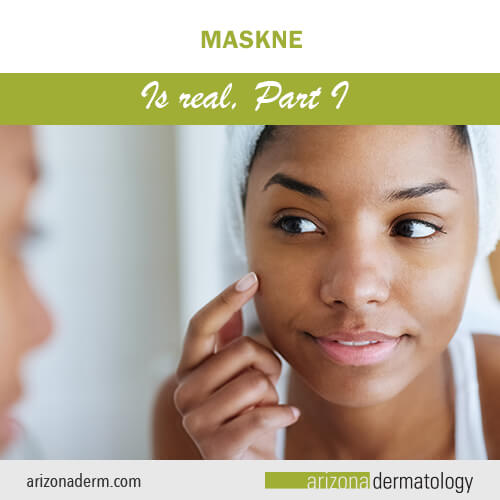 Covid-19 has coined a new term: maskne, referring to acne breakouts happening as a result of wearing a mask. If you’ve been noticing red bumps on your face, more or worse acne breakouts, or irritated areas on your face, it might be “maskne.”
Covid-19 has coined a new term: maskne, referring to acne breakouts happening as a result of wearing a mask. If you’ve been noticing red bumps on your face, more or worse acne breakouts, or irritated areas on your face, it might be “maskne.”
Is my mask making me break out?
The answer to this question is probably yes. That said, don’t stop wearing one! The CDC still recommends you wear a mask to protect yourself and others while in public. One of the drawbacks, however, is that wearing a mask traps heat and moisture against your face, creating the ideal breeding ground for bacteria. In the areas where the mask makes physical contact with your skin, irritation can occur, exacerbating the problem.
If you already suffer from acne, wearing a mask can make it worse. However, many people who have not had acne in the past are suddenly getting breakouts.
What is maskne, really?
The medical term for maskne is acne mechanica, a word that describes acne caused by environmental conditions. The mask over your face traps heat and moisture, keeps the skin from breathing, and rubs against your skin in places. As a result, your pores can clog, bacteria thrives, and you can develop a rash, pimples or acne cysts.
In addition to acne, masks can cause or worsen other skin conditions.
Contact dermatitis is an allergic skin reaction that can occur when your skin comes into contact with certain chemicals found in manufactured masks (like formaldehyde or bronopol).
Rosacea is a skin condition characterized by redness, visible blood vessels in the face, and small, red, pus-filled bumps. Heat exacerbates the condition, meaning your mask could also make your rosacea flare up.
Folliculitis occurs when hair follicles become inflamed due to a bacterial or fungal infection. It can produce pimple-like red bumps or whiteheads.
Seborrheic dermatitis is the medical term for dandruff, but it can also cause an itchy, scaly rash on oily areas of the face.
Who is most at risk?
People who are wearing masks for a large part of their day are most at risk of developing maskne. These include healthcare professionals and front line workers, especially if they are wearing particularly tight-fitting masks. The American Academy of Dermatology produced a document regarding skin damage resulting from personal protective equipment (PPE) like masks, noting that 97% of health care workers showed signs of skin damage, most commonly on the bridge of the nose, cheeks and forehead, as well as the hands (from hand washing). Those who wore their mask for six or more hours a day had the most complaints.
Just because you don’t wear a mask all day doesn’t mean you won’t notice more breakouts. Anecdotally, even people who only wear their mask for errands are also noting an uptick in facial acne.
Now that kids and teens are back in school, we expect to see more issues with acne in that age group as well, something parents and guardians should be aware of because uncontrolled acne can take a toll on kids’ self esteem.
What can I do about maskne?
If maskne is a problem for you or your child, there are things you can do to prevent it and treat it at home. If at-home measures don’t work, especially if mask wearing is exacerbating a skin problem you already have, your dermatologist can help.
Read our “Maskne is real, Part II” blog on prevention and treatment here.


